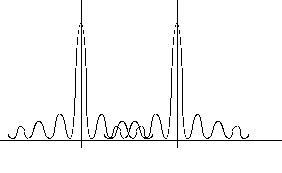

Optical Resolution
If we look closely enough, every image is surrounded by a diffraction pattern produced by the wave nature of light as it passes through an opening like the edge of a lens.
The diffraction pattern produced by a circular opening is very similar to that produced by a single slit.
For a slit, the angular distance from the center of the central maximum to the first minimum is
.
For a circular opening, the angular distance from the center of the central maximum to the first minimum is

If we look at two stars that have a large angular separation, their diffraction patterns hardly overlap, and we clearly distinguish that there are two stars.
The same would be true of two items of cell structure when viewed through a microscope.
As the two objects come closer, their diffraction patterns overlap and it may become difficult to distinguish the two images.

"Rayleigh's criterion" for the resolution of two point sources is that the first minimum of one diffraction pattern occurs at the central maximum of the other one.
Untrained eyes will loose distinction before this and well trained eyes may distinguish two sources even closer than Rayleigh's criterion.
Return to Ch 25, Wave Optics: Interference and Diffraction (c) Doug Davis, 2002; all rights reserved